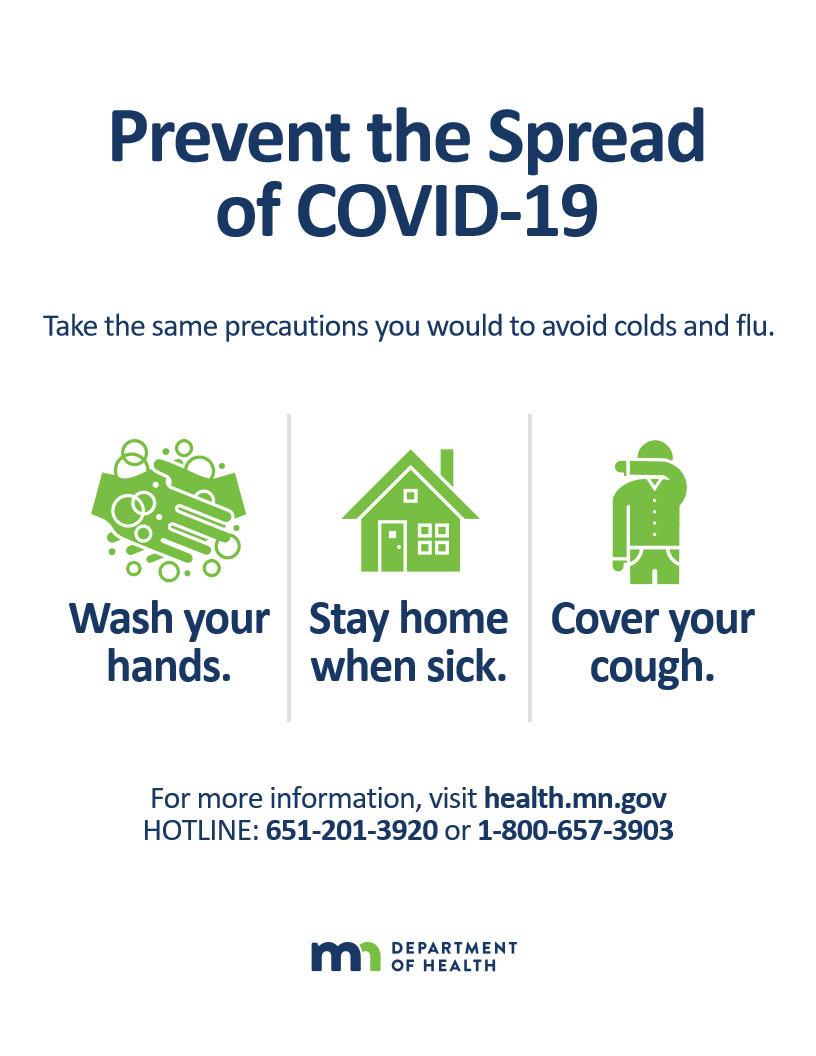
COVID-19 Resources
Do you have questions about COVID-19, or the new coronavirus, in regards to where you live in northeast Minnesota? Please use the information about state and county resources below to start your search.
Minnesota Department of Health:
https://www.health.state.mn.us/diseases/coronavirus/index.html
The Minnestoa Department of Health is offering a hotline seven days a week, 8 am – 4:30 pm. The contact number is 651-201-3920.
Aitkin County:
Brea Hamdorf, Aitkin County Public Health – (218) 927-7256 or This email address is being protected from spambots. You need JavaScript enabled to view it.
Carlton County:
Public Health & Human Services – (218) 879-4511
http://www.co.carlton.mn.us/
Cook County:
Public Health (218) 387-3620
https://www.co.cook.mn.us/
Itasca County:
Anna Anttila, Itasca County Public Health – (218) 327-2941 or This email address is being protected from spambots. You need JavaScript enabled to view it.
Itasca County Public Health is offering information phone line 218-327-6784. The Public Health Team will answer and return calls Monday – Friday, 8 am – 4:30 pm
Koochiching County:
Health and Human Services – (218) 283-7000 OR Toll-Free: 800-950-4630
https://www.co.koochiching.mn.us/CivicAlerts.aspx?AID=75
Lake County:
Health and Human Services – (218) 834-8400 OR 218-226-4443
https://www.co.lake.mn.us/departments/emergency_management/situation_updates.php
Saint Louis County:
Public Health – (218) 625-3600 (M-F, 8am-4:30pm)
https://www.stlouiscountymn.gov/departments-a-z/public-health-human-services/public-health/coronavirus-information

Itasca County Public Health:
COVID-19 Situational Update for March 19, 2020
- Worldwide: The World Health Organization declared COVID-19 as a pandemic on March 11, 2020 due to cases have been detected in most countries worldwide and community spread is being detected in a growing number of countries. Pandemics happen when a new virus emerges to infect people and can spread between people sustainably. Because there is little to no pre-existing immunity against the new virus, it spreads worldwide.
As of yesterday March 18:
- 191,127 confirmed positive cases
- 7,807 deaths
- Nationally: Different parts of the country are seeing different levels of COVID-19 activity, however all states are experiencing increasing numbers.
U.S. COVID-19 cases include:
Imported cases in travelers
Cases among close contacts of a known case
Community-acquired cases where the source of the infection is unknown.
National statistics are updated by the CDC Mon-Friday. As of today:
- Total cases: 10,442
- Total deaths: 150
- Jurisdictions reporting cases: 54 (50 states, District of Columbia, Puerto Rico, Guam, and US Virgin Islands)
- Community transmission is occurring in 23 states (including MN)
- Minnesota: The MN Dept of Health is tracking stats of COVID-19. As of today:
- 3,038 people have been tested
- 89 positive cases have been identified in MN. No deaths have occurred in MN
- Counties with cases: Anoka, Benton, Blue Earth, Carver, Dakota, Hennepin, Martin, Mower, Nicollet, Olmsted, Ramsey, Renville, Rice, Scott, Stearns, Waseca, Washington, Wright
- No cases have been identified in Itasca County
- Community transmission has occurred in MN in 6 cases (list of counties unavailable at this time, but none in Itasca)
- MN (along w/ the rest of the country) continues to be in the containment phase and has implemented mitigation strategies at the community level
Sources:
MDH https://www.health.state.mn.us/diseases/coronavirus/situation.html
CDC https://www.cdc.gov/coronavirus/2019-ncov/cases-updates/cases-in-us.html#reporting-cases
Stress and Coping
The outbreak of coronavirus disease 2019 (COVID-19) may be stressful for people. Fear and anxiety about a disease can be overwhelming and cause strong emotions in adults and children. Coping with stress will make you, the people you care about, and your community stronger.
Everyone reacts differently to stressful situations. How you respond to the outbreak can depend on your background, the things that make you different from other people, and the community you live in.
People who may respond more strongly to the stress of a crisis include
- Older people and people with chronic diseases who are at higher risk for COVID-19
- Children and teens
- People who are helping with the response to COVID-19, like doctors and other health care providers, or first responders
- People who have mental health conditions including problems with substance use
Stress during an infectious disease outbreak can include
- Fear and worry about your own health and the health of your loved ones
- Changes in sleep or eating patterns
- Difficulty sleeping or concentrating
- Worsening of chronic health problems
- Increased use of alcohol, tobacco, or other drugs
People with preexisting mental health conditions should continue with their treatment and be aware of new or worsening symptoms. Additional information can be found at the Substance Abuse and Mental Health Services Administration (SAMHSAexternal icon) website.
Taking care of yourself, your friends, and your family can help you cope with stress. Helping others cope with their stress can also make your community stronger.
Things you can do to support yourself
- Take breaks from watching, reading, or listening to news stories, including social media. Hearing about the pandemic repeatedly can be upsetting.
- Take care of your body. Take deep breaths, stretch, or meditate. Try to eat healthy, well-balanced meals, exercise regularly, get plenty of sleep, and avoid alcohol and drugs.
- Make time to unwind. Try to do some other activities you enjoy.
- Connect with others. Talk with people you trust about your concerns and how you are feeling.
Call your healthcare provider if stress gets in the way of your daily activities for several days in a row.
Coronavirus (COVID-19) Screening and Triage
We’ve created an assessment based on CDC guidance to help you protect yourself and loved ones and to know when to stay home and when to seek testing or medical attention.
Given the current shortage of testing availability and facilities, we currently are not ordering testing. However, we can help determine if you need it and provide the information to contact your local health department.
This service includes:
Patient evaluation based on medical history, symptoms, and recent travel
Counseling and education based on CDC guidelines
Recommendations on how and when to use social distancing or home isolation
Advice for when to seek testing or urgent medical attention
A visit is free of charge ($0).
How HeyDoctor Works
Board-certified, experienced doctors use HeyDoctor to provide a private doctor's visit from your home - so you get help, fast.

Quick Secure Online Visit
Complete a simple visit on your phone or computer.

Get A Treatment Plan
A healthcare provider will determine if a prescription is safe and appropriate.

Chat Anytime
Chat with your board-certified doctor anytime.
We are committed to providing parents regular communication as the situation unfolds. Our primary method of communication is through our Blackboard Mass Notification System. If you do not receive the messages, please contact your building secretary to ensure your contact information is current. You may also verify your contact information in Campus Parent.
We will also share regular updates through the following sources:
Parents are encouraged to contact district staff members with educational questions or rumors about the illness in district buildings.
Parents who are concerned about the virus itself should contact the Minnesota Department of Health hotline at 651-201-3920, open from 7:00 am to 7:00 pm. Itasca County Health has also created a local hotline at 218-327-2941.
Childcare for emergency workers:
During this time of school closures, our Itasca Area Schools have been asked to support our families who are employed in the emergency services. If you are employed in emergency services and have a child enrolled in IASC schools grades K-12, you can request childcare using this form.
PLEASE ONLY FILL OUT THIS FORM IF YOU MEET THE CRITERIA AND NEED CHILDCARE
The Governor has defined emergency services workers as: providers of healthcare, emergency medical services, long-term and post-acute care; law enforcement personnel; personnel providing correctional services; public health employees; firefighters and other first responders; and court personnel. Recipients of childcare must be school-aged children Kindergarten through 12 years who are enrolled in the school district. Childcare will be provided during school hours.
The purpose of this support is to enable our emergency workers to help keep our community safe.
If you have alternative childcare or a spouse working from home, please consider taking advantage of that. IASC Districts are still attempting to limit large groups of children.
MDE's School-Aged Childcare Q&A
When do school districts and charter schools need to begin providing school-age care services for emergency workers?
- The expectation is that all school districts and charter schools have a plan in place to begin offering school-age care services to children of healthcare and emergency workers as of Wednesday, March 18, 2020. We encourage districts and charter schools who are closed on Monday, March 16 and Tuesday, March 17 to have a plan in place if a child comes to school.
What is the cost of school-age care for children of emergency workers?
- There is no cost for child care services during normal school hours for children of healthcare and emergency workers. The expectation is that districts and charter schools are providing that care through licensed staff, paraprofessionals and/or other support staff who would normally be working during the school day.
Will educators’ children be eligible for the school-age care for children of emergency workers services during the school day?
- Because school staff are so critical in providing care for emergency workers, schools and districts are strongly encouraged to allow their educators to access the same care for children of families of emergency workers.
Will schools still continue to practice the Minnesota Department of Health’s guidelines on hygiene and social distancing while students are participating in school-age care?
- Yes. Hygiene and social distancing practices will be applied including washing hands, avoiding large gatherings of 250+ and maintaining 6 feet of distance for smaller groups. For more information, visit the MDH Coronavirus disease web page for schools and child care.
Can any program run in a school during the closure period?
- No. Aside from working on distance learning plans and care for children of emergency workers, there can be no additional programming in schools during the closure period.
How do you define healthcare and emergency workers?
- See the image below for the Governor’s definition.
CALL-IN RECOVERY MEETINGS
HOSTED BY MINNESOTA RECOVERY CONNECTION
To join a recovery meeting at its scheduled time:
Dial in to: 612-351-3093 Enter Code: 8 2 7 1 7 7 SCHEDULED MEETINGS:
Mondays
Women’s All Recovery Meeting 5:00 - 6:00 PM
Tuesday
All Recovery Meeting for all 2:00 - 3:00 PM
Thursday
LGBTQ+ All Recovery Meeting 6:00 - 7:00 PM
Saturday
Dual-Diagnosis All Recovery Meeting 10:00 - 11:00 AM
All Recovery Meeting for all 11:00 AM - 12:00 PM

Stress and Coping
The outbreak of coronavirus disease 2019 (COVID-19) may be stressful for people. Fear and anxiety about a disease can be overwhelming and cause strong emotions in adults and children. Coping with stress will make you, the people you care about, and your community stronger.
Everyone reacts differently to stressful situations. How you respond to the outbreak can depend on your background, the things that make you different from other people, and the community you live in.
People who may respond more strongly to the stress of a crisis include
- Older people and people with chronic diseases who are at higher risk for COVID-19
- Children and teens
- People who are helping with the response to COVID-19, like doctors and other health care providers, or first responders
- People who have mental health conditions including problems with substance use
Stress during an infectious disease outbreak can include
- Fear and worry about your own health and the health of your loved ones
- Changes in sleep or eating patterns
- Difficulty sleeping or concentrating
- Worsening of chronic health problems
- Increased use of alcohol, tobacco, or other drugs
People with preexisting mental health conditions should continue with their treatment and be aware of new or worsening symptoms. Additional information can be found at the Substance Abuse and Mental Health Services Administration (SAMHSAexternal icon) website.
Taking care of yourself, your friends, and your family can help you cope with stress. Helping others cope with their stress can also make your community stronger.
Things you can do to support yourself
- Take breaks from watching, reading, or listening to news stories, including social media. Hearing about the pandemic repeatedly can be upsetting.
- Take care of your body. Take deep breaths, stretch, or meditate. Try to eat healthy, well-balanced meals, exercise regularly, get plenty of sleep, and avoid alcohol and drugs.
- Make time to unwind. Try to do some other activities you enjoy.
- Connect with others. Talk with people you trust about your concerns and how you are feeling.
Call your healthcare provider if stress gets in the way of your daily activities for several days in a row.
